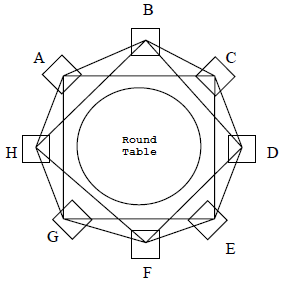NOI '07 P5 - Counting Spanning Trees
View as PDFNational Olympiad in Informatics, China, 2007
Recently, Alex has made shocking advances in the technique of counting spanning trees in undirected, connected graphs. He discovered:
- A cycle with
nodes contains
distinct spanning trees.
- A complete graph with
nodes contains
distinct spanning trees.
These two discoveries have made Alex ecstatic, so he would like to continue on his adventure of counting spanning trees. That is, he would like to be able to count the number of spanning trees in all kinds of different graphs.
One day, Alex is meeting up with his peers. Everyone sat in a circle
around a big round table. After taking a look, Alex immediately recalls
his spanning tree problem. If he considers each of his peers as a node
and neighboring peers (nodes with a distance of between them) to be
connected by an edge, then this becomes a cycle. However, Alex has
already mastered calculations on cycles and is not really interested
anymore. So, he changed the graph up a bit: Not only does he add an edge
between neighboring peers, but he also adds an edge between pairs of
peers who are separated by a single seat (nodes with a distance of
between them). Now, he considers peers connected by a single edge to be
adjacent, as depicted in the following figure.

Alex has never tried counting spanning trees on this kind of graph
before, however, he recalls his teacher explaining that there is a
general method for counting the number of spanning trees on any type of
graph. First, construct an matrix
such that:
where represents the degree of node
.
Let's construct the matrix corresponding to the graph of the round
table as depicted above. To count the number of spanning trees, we only
have to remove the last row and column of
, obtaining an
matrix which we shall call
. Computing the
determinant of matrix
will yield the number of spanning trees in the
graph above.
Therefore the number of spanning trees in this graph is .
Alex noticed that using the general method, calculations are very
complex and tedious. Yet, he cannot find any other formulas that are
simpler than this. So, he simplified the graph. At some place, he broke
apart the circle around the table. This way, his peers form a chain of
nodes, where an edge exists between all pairs of nodes with a distance of
or a distance of
between them. The case for
nodes is depicted
below:
This way, the total number of spanning trees is reduced by a great
amount. Alex just thinks and thinks, until the entire meeting is over.
Finally, he comes up with an efficient method to count the number of
spanning trees in this graph. However, if he also decides to join nodes
with a distance of , then once again he will not know how to find the
answer efficiently. Please help Alex count the number of spanning trees
in these types of graphs!
Input Specification
The input contains two integers and
, separated by a space.
means that all nodes with a distance no greater than
are to be
linked by an edge in the graph.
indicates that there are
total
nodes.
Output Specification
Output a single integer, the number of spanning trees in the graph.
Since the answer can be rather large, you are required to output the
answer modulo .
Sample Input
3 5Sample Output
75Explanation
The graph for the sample is depicted below:
Constraints
For all the test cases, .
| Test Case | Range of |
Range of |
Test Case | Range of |
Range of |
|---|---|---|---|---|---|
Hints
One method to compute the determinant is to first let represent
the number of
inversions
in the sequence
. Then, the determinant of
is calculated using
the formula:
If , then the calculations are as follows:
Therefore the determinant of is
.
Problem translated to English by .
Comments